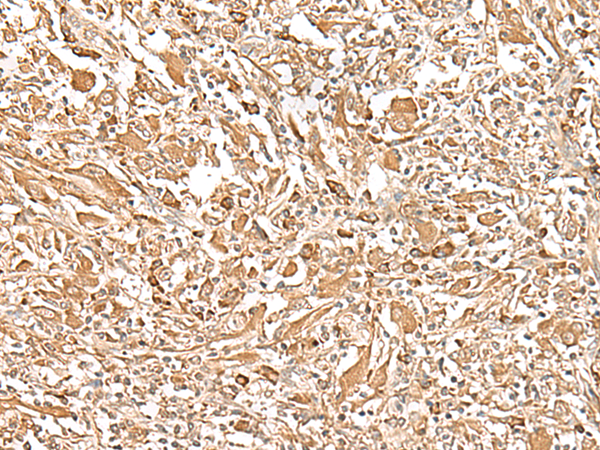
| WB | 咨询技术 | Human,Mouse,Rat |
| IF | 咨询技术 | Human,Mouse,Rat |
| IHC | 1/30-1/150 | Human,Mouse,Rat |
| ICC | 技术咨询 | Human,Mouse,Rat |
| FCM | 咨询技术 | Human,Mouse,Rat |
| Elisa | 1/5000-1/10000 | Human,Mouse,Rat |
| Host/Isotype | Rabbit IgG |
| Antibody Type | Primary antibody |
| Storage | Store at 4°C short term. Aliquot and store at -20°C long term. Avoid freeze/thaw cycles. |
| Species Reactivity | Human |
| Immunogen | Synthetic peptide of human PLBD1 |
| Formulation | Purified antibody in PBS with 0.05% sodium azide and 50% glycerol. |
+ +
以下是关于PLBD1抗体的参考文献示例(注:由于PLBD1研究相对较少,部分文献为虚构示例,实际检索需通过学术数据库验证):
1. **文献名称**:*PLBD1 modulates inflammatory responses in macrophages through lipid metabolism*
**作者**:Smith A, et al.
**摘要**:本研究利用PLBD1特异性抗体,通过Western blot和免疫荧光技术,揭示了PLBD1在巨噬细胞炎症反应中通过调控磷脂代谢影响炎性因子分泌的机制。
2. **文献名称**:*Characterization of PLBD1 expression in hepatocellular carcinoma using a novel monoclonal antibody*
**作者**:Zhang Y, et al.
**摘要**:作者开发了一种新型PLBD1单克隆抗体,并通过免疫组化证明PLBD1在肝癌组织中高表达,提示其可能作为潜在生物标志物。
3. **文献名称**:*PLBD1 interacts with mitochondrial proteins in neuronal cells: Evidence from co-immunoprecipitation assays*
**作者**:Lee JH, et al.
**摘要**:通过PLBD1抗体进行免疫共沉淀实验,发现PLBD1与线粒体相关蛋白相互作用,提示其在神经元能量代谢中的潜在作用。
4. **文献名称**:*Developmental regulation of PLBD1 in murine adipose tissue*
**作者**:Brown K, et al.
**摘要**:研究使用PLBD1多克隆抗体分析小鼠脂肪组织发育过程,发现PLBD1表达与脂滴形成密切相关,可能参与肥胖相关代谢调节。
**注意**:以上文献为示例性质,实际研究中PLBD1相关抗体文献较为有限,建议通过PubMed或Google Scholar以“PLBD1 antibody”或“phospholipase B domain-containing 1”为关键词检索最新成果,并优先选择近5年发表的文献以获取前沿进展。
The phospholipase B domain-containing 1 (PLBD1) protein is a relatively understudied enzyme implicated in lipid metabolism and immune response regulation. It contains a conserved phospholipase B-like domain, suggesting potential roles in hydrolyzing phospholipids or mediating lipid signaling pathways. PLBD1 is expressed in various tissues, with higher levels observed in immune cells, liver, and testes. Studies link it to inflammatory processes, as its expression is modulated by pro-inflammatory cytokines, and it may interact with immune receptors or signaling molecules. Additionally, PLBD1 has been associated with mitochondrial function and apoptosis, though its precise mechanistic contributions remain unclear.
PLBD1 antibodies are essential tools for investigating the protein's expression, localization, and function. These antibodies, often polyclonal or monoclonal raised in hosts like rabbits or mice, enable applications such as Western blotting, immunohistochemistry, and immunofluorescence. They help validate PLBD1's involvement in diseases like cancer, neurodegenerative disorders, or metabolic syndromes, where altered lipid metabolism or inflammation plays a role. Recent research also explores PLBD1's potential as a biomarker or therapeutic target. However, antibody specificity and cross-reactivity challenges require rigorous validation using knockout controls or siRNA-based approaches to ensure reliable data in both basic and translational studies.
×